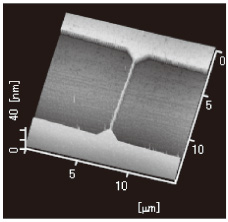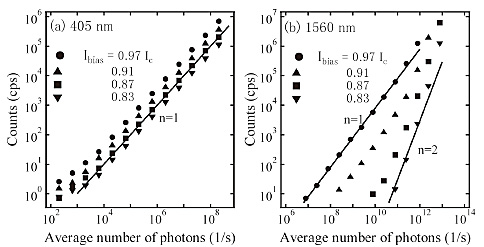Optical Science Laboratory, *Physical Science Laboratory
Magnesium diboride (MgB2) is a next generation superconducting material because of its highest
Tc=39 K among intermetallic compounds and of its simple crystal structure with only two elements. We have reported that it is possible to grow MgB2 ultra-thin films using molecular beam epitaxy (MBE) with a precise control
of evaporation ratio of Mg and B vapors [1]. We have also reported that
it is possible to fabricate nano-patterns of MgB2 by the liftoff process using amorphous carbon as a resist, which can bear
at high temperature during MgB2 deposition [1]. Recently, we have fabricated an MgB2 nanowire with the dimension of 100-nm-width and 10-nm-thick and have demonstrated that the nanowire can detect single-photons in the visible to infrared wavelength range [2].
Figure 1 shows the atomic force microscopy (AFM) image of MgB2 nanowire. The uniform shape of the nanowire demonstrates that the liftoff
process works well. The transport measurement also showed that the nanowire
has no damage during nano-fabrication process. The single-photon detection
capability can be confirmed by investigating the statistics regarding the
number of detected signals and the average number of photons illuminating
the nanowire. When the illumination is a weakly coherent light source with
a Poisson distribution, the probability of detecting one photon is proportional
to the average number of photons µ. Figure 2(a) shows the µ
dependence of the number of detected signals at wavelength of 405 nm. The
dependence is linear, confirming the single-photon detection capability
of the nanowire. At 1560 nm, quadratic dependence is observed in Fig. 2(b)
in the low bias region. This indicates that the energy of single-photon
at 1560 nm is not enough to make electric signals and more than two-photons
are necessary to make signals. The dependence changes linear as the bias
increases higher, demonstrating the single-photon detection capability
of the nanowire even at 1560 nm. We will try to fabricate a single-photon
detector for the quantum information and quantum optics using MgB2 nanowire.
This work was supported by KAKENHI.
[1] H. Shibata et al., IEEE Trans. Appl. Supercond. 19 (2009) 358; H. Shibata et al., Physica C 470 (2010) S1005.
[2] H. Shibata et al., Appl. Phys. Lett. 97 (2010) 212504.
 |
 |
|||||
|
|